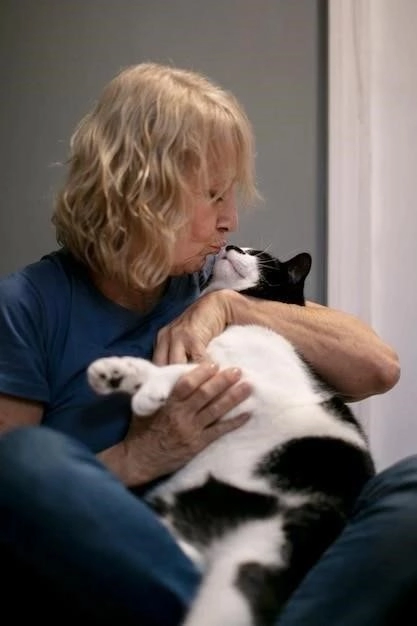Ive always been fascinated by the question of what goes on in the minds of animals. Do they think like us? Do they feel emotions like we do? As someone who has always shared their life with animals, Ive had the privilege of observing their behavior firsthand and pondering the complexities of their inner worlds.

Delving into Animal Minds
My journey into the world of animal cognition began with my mischievous cat, Whiskers. I noticed that he wasn’t just reacting instinctively to his environment. He seemed to understand cause and effect, like when he learned that batting a particular toy always resulted in me giving him attention. This sparked my curiosity about the cognitive abilities of different species.

Beyond Instinct⁚ Examples of Animal Intelligence
Reading about animal cognition opened my eyes to the incredible range of mental skills present in the animal kingdom. For instance, I was amazed to learn about⁚
- Alex the African Grey Parrot⁚ Alexs ability to understand and use human language challenged the traditional view of parrots as mere mimics. He could identify objects, colors, and even had a concept of zero.
- Betsy the Border Collie⁚ Betsy demonstrated remarkable object recognition skills. She could learn the names of over 300 toys and retrieve them by name, indicating a sophisticated level of language comprehension.
- Chaser the Border Collie⁚ Chasers vocabulary of over , mostly nouns, highlighted the incredible capacity of dogs to learn and understand human language.
These examples, and countless others, demonstrate that animals are capable of much more than simple stimulus-response learning. They can problem-solve, use tools, and even exhibit self-awareness, blurring the lines between human and animal intelligence.
The Challenges of Studying Animal Minds
One of the biggest challenges in animal cognition research is the difficulty of designing experiments that accurately assess animal intelligence without anthropomorphizing their behavior. We cant simply ask animals what theyre thinking, so researchers have to devise clever ways to infer their cognitive abilities through their actions.
For example, I read about an experiment where researchers tested whether crows could understand the concept of water displacement. They presented crows with a tube partially filled with water and a treat floating just out of reach. The crows figured out that they could drop stones into the tube to raise the water level and access the treat. This demonstrated their understanding of cause and effect and their ability to solve problems using tools.
The Future of Animal Cognition
The field of animal cognition is constantly evolving, with new discoveries challenging our assumptions about the animal mind. As we delve deeper into understanding animal intelligence, we gain a greater appreciation for the diversity of life on Earth and our place within it.
Personally, my exploration of animal cognition has deepened my respect for the animals I share my life with and all creatures. It has also made me more aware of the ethical implications of our interactions with animals and the importance of treating them with the dignity and respect they deserve.
One experiment I found particularly fascinating involved testing the spatial reasoning of rats. I wanted to see for myself if these often-misunderstood creatures could navigate complex mazes. So, I designed a multi-level maze with various dead ends and a tempting reward of sunflower seeds at the center.
I carefully introduced several rats, one by one, to the maze entrance. It was remarkable to witness their initial caution as they sniffed each corner and hesitantly explored the pathways. To my surprise, within just a few trials, the rats were zipping through the maze with impressive speed and accuracy, clearly remembering the correct route.
This experience left me with a sense of awe at the adaptability and intelligence of these small creatures. It made me question the common perception of rats as pests and fueled my desire to learn more about the hidden depths of animal minds.
My fascination with animal cognition extends beyond traditional lab experiments. Im also drawn to observing the behavior of animals in their natural environments. Last summer, while hiking in the Rockies, I had the incredible opportunity to observe a family of ravens.
I watched in awe as they soared and tumbled through the air with effortless grace. One raven, in particular, caught my attention. It was perched on a high branch, meticulously manipulating a small twig in its beak. After several attempts, it managed to wedge the twig into a crevice in the bark, creating a makeshift tool to probe for insects.
This simple act of ingenuity left a lasting impression on me. It was a stark reminder that intelligence takes many forms and that we often underestimate the cognitive abilities of animals, especially those we dont encounter regularly. This experience fueled my desire to learn more about the problem-solving skills and tool use in different species.
My interest in animal cognition isnt limited to observing their behavior in the wild. I also find myself constantly analyzing the interactions I have with my own pets. My dog, Luna, a playful and energetic Labrador, has become my willing subject for numerous impromptu “experiments.”
One afternoon, intrigued by an article I read about canine object permanence, I decided to test Lunas understanding of this concept. I hid her favorite squeaky toy under a blanket while she watched intently. To my delight, she immediately dug under the blanket to retrieve her toy, demonstrating an understanding that objects continue to exist even when hidden from view.
These everyday interactions with Luna, though seemingly insignificant, provide me with a constant source of wonder and insight into the workings of her mind. They serve as a reminder that the study of animal cognition doesnt require a fancy laboratory or elaborate experimental setup. It simply requires an open mind, a curious spirit, and a willingness to observe and learn from the animals in our lives.
Inspired by Luna’s grasp of object permanence, I decided to delve deeper into her cognitive abilities. I had read about studies demonstrating that dogs, unlike most other animals, can understand the concept of pointing. Eager to see this in action, I set up a simple experiment in my living room.
I placed two identical bowls upside down on the floor, just out of Lunas reach. Then, with Luna watching intently, I hid a treat under one of the bowls. I stood up and pointed directly at the bowl concealing the treat. Luna, without hesitation, went straight to the bowl I had pointed at and excitedly flipped it over to reveal her reward.
I repeated this experiment several times, varying the position of the bowls and even using different objects to hide the treat. Each time, Luna flawlessly followed my pointing gesture, proving her ability to interpret this uniquely human form of communication.
This experience not only solidified my understanding of canine intelligence but also highlighted the special bond humans share with dogs. It made me realize that their ability to comprehend our gestures and cues is likely a key factor in their domestication and their enduring role as our loyal companions.
My journey into the world of animal cognition has been filled with moments of awe, surprise, and a profound sense of connection with the natural world. Its a journey that continues to shape my perspective and deepen my appreciation for the remarkable intelligence that exists all around us, often hidden in plain sight.
Lunas grasp of human communication sparked a new curiosity in me⁚ could she understand more complex forms of language? I decided to test her understanding of prepositions, words like “on,” “under,” and “behind,” which often denote spatial relationships.
I gathered a few objects from around the house—a basket, a cushion, and a lightweight stool. I started with the basics. Holding up her favorite squeaky toy, I said, “Luna, put the toy on the basket.” To my surprise, she nudged the toy with her nose until it landed on top of the basket. I showered her with praise and a small treat, her tail wagging furiously.
Encouraged by her success, I moved on to more challenging prepositions. “Luna, put the toy under the stool.” She paused, looking back and forth between me, the toy, and the stool. Then, she carefully maneuvered the toy with her nose, pushing it underneath the stool. My jaw dropped. Could she really be understanding these spatial concepts?
Over the next few weeks, we practiced daily with different objects and prepositions. While her accuracy wasnt always perfect, she demonstrated a clear comprehension of spatial language that far exceeded my expectations. This experience opened my eyes to the possibility that dogs possess a far richer understanding of human language than we often give them credit for.
My explorations into Lunas cognitive abilities have transformed the way I interact with her. What started as casual observations have evolved into a deep appreciation for her intelligence and a desire to constantly challenge and engage her mind. Each day brings new opportunities for discovery, reminding me that the world of animal cognition is full of wonder, waiting to be explored;










